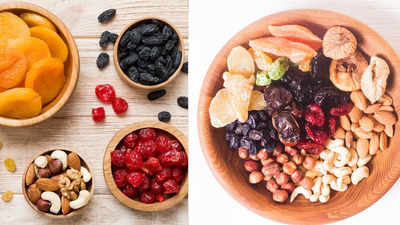Trending
5 Simple ways to convert any sesaonal fruit into dry fruits
Dehydrating fresh fruits into dried fruits can be conveniently done at home using methods like sun drying, oven drying, using a dehydrator, microwave drying, or freeze drying. Each method offers a unique way to retain the taste, texture, and health benefits of the fruits efficiently.
Dried fruits are a convenient, healthy snack, easy to store for long periods and retain the concentrated flavors and nutrients of the fresh fruits in a more durable form. Dehydrating fresh fruits into dried fruits is quite simple and may easily be done at home with minimal equipment. Here are five easy ways to dehydrate any fruit and transform it into dry fruit while retaining its taste, texture, and health benefits.
Sun Drying
Put the slices on a non-stick clean surface, preferably a tray or mesh rack, with space in between them for good air circulation. Cover the fruit with cheesecloth or net to keep the insects away. The time taken by the fruit to dry completely varies from 2 to 4 days, depending on the temperature and humidity. Sun drying is best done in a warm, dry, and sunny climate so that the fruit does not get damp or spoiled.
Oven Drying
Dehydrator Method
When using a dehydrator to dehydrate fruit, slice the fruit into thin pieces. Some fruits, such as apples and pears, must be blanched before dehydrating to save color and texture. Place slices on the dehydrator trays so that they do not overlap. Set the dehydrator to the temperature recommended for most fruits, usually around 135°F (57°C). Dehydration time depends upon the fruit but most fruits require 6 to 12 hours. When done, the fruits should be completely dry and have a leathery, chewy texture.
Microwave Drying
Place the fruit slices on a microwave-safe plate lined with paper towels. Cover it with a microwave-safe cover or lid to keep moisture from building up while microwaving. Put your microwave on the defrost or low-power setting and start microwaving in 1-2 minute intervals. After each interval, check the level of moisture in the fruit and rearrange the slices. Do this until the fruit is dry and leathery. Note that this process works best with softer fruits such as apples, strawberries, and peaches.
Freeze Drying
For that, you would need a freeze dryer, which is specialized equipment to freeze-dry fruits at home. First, cut the fruit into small pieces and place them on the freeze dryer trays. Inside the device, the fruit gets frozen first and then is subjected to low pressure and heat; this causes the water content to slowly evaporate. This can take hours to finish. Freeze-dried fruits are really great for long-term storage and are used in many commercial products, such as smoothies or snacks.
End of Article
FOLLOW US ON SOCIAL MEDIA
Visual Stories
Tired of too many ads?go ad free now



















